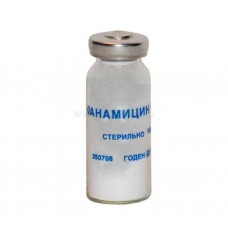Expiration date: 12/2026
Composition
Powder for preparation of injection solution contains: kanamycin sulfate 1 g.
Packaging
The package contains bottle of 1 gr.
Pharmacological action
Kanamycin sulfate is active against most gram-positive and gram-negative microorganisms: Staphylococcus spp., Escherichia coli, Enterobacter spp. (including Enterobacter aerogenes), Serratia, Klebsiella pneumoniae, Proteus spp., Shigella spp., Salmonella spp., and for Mycobacterium tuberculosis strains resistant to streptomycin, PASC, isoniazide and other anti-tuberculosis drugs (except viomycin). Ineffective or ineffective against Streptococcus spp., Pseudomonas aeruginosa, Bacteroides spp. et al. anaerobic bacteria, fungi, viruses and most protozoa. Strains of microorganisms resistant to benzylpenicillin, streptomycin, levomycetin, tetracycline, erythromycin, etc., in most cases remain sensitive to kanamycin (kanamycin sulfate and kanamycin monosulfate).
Indications
Severe purulent-septic diseases (sepsis, meningitis, peritonitis, septic endocarditis), infectious and inflammatory diseases of the respiratory system (pneumonia, lung abscess, empyema of the pleura, etc.), infections of the kidneys and urinary tract (pyelonephritis, cystitis, urethritis), purulent complications in the postoperative period, infected burns and other diseases caused by microorganisms sensitive to the drug (including resistant to tuberculosis, etc.). lung and other organs (with resistance to TB drugs I and II series).
Contraindications
Hypersensitivity, defeat VIII pairs of cranial nerves, impaired liver and kidney function, obstruction of the gastrointestinal tract (when administered orally).
With caution (only on vital indications) — pregnancy, premature babies, newborn period (up to 1 month).
Application during pregnancy and breast-feeding
When pregnancy is possible only for health reasons.
Method of application and doses
V/m, in/in the drip vnutripolostno. In / m, a single dose (0, 5 or 1 g) is dissolved in 2 or 4 ml of water for injection or 0, 25-0, 5% novocaine solution.
In / drip, a single dose (0, 5 g) is dissolved in 200 ml of 5% glucose solution or isotonic sodium chloride solution and administered at a rate of 60-80 drops / min.
At infections of nontubercular etiology single dose for adults at/m and / in the introduction-0, 5 g, daily-1-1, 5 g (0, 5 g every 8-12 h), the maximum daily dose — 2 g (1 g after 12 h). The course of treatment-5-7 days. Children (only / m): the average daily dose for children under 1 year — 0, 1 g/day, from 1 to 5 years — 0, 3 g/day, older than 5 years — 0, 3-0, 5 g/day, the maximum daily dose — 15 mg/kg, the daily dose is divided into 2-3 administration, premature and children of the first month of life — only for life indications.
In tuberculosis - / m, adults-1 g 1 time per day, children-15 mg/kg / day. Every 7-th day — break, the number of cycles and the total duration of treatment depending on the stage and characteristics of the disease.
In the cavity (pleural, articular) for washing, 10-50 ml of 0, 25% aqueous solution is injected (the daily dose should not exceed the recommended dose for parenteral administration). When carrying out peritoneal dialysis: 1-2 g dissolved in 500 ml of dialysis fluid liquid. Duration intracavitary applications is determined by the characteristics of the disease.
In the treatment of pulmonary tuberculosis and infections of the respiratory tract non-tuberculosis etiology injection solution can be used in the form of aerosol and water inhalation (temperature 35-40 °C). Dissolve 0, 25-0, 5 g in 3-5 ml isotonic sodium chloride solution or distilled water, a single dose for adults — 0, 25-0, 5 g, for children — 5 mg/kg, the duration of treatment for acute diseases — 7 days, with chronic pneumonia — 15-20 days, with tuberculosis — 1 month or more.
Side effect
Ototoxicity (hearing loss, rarely-irreversible deafness), nephrotoxicity (proteinuria, the appearance of red blood cells in the urine, leukocytes, cylindrical epithelium), parenteral administration (mainly in/in and intracavitary)-neuromuscular blockade
Special instruction
In renal insufficiency, the administration of kanamycin sulfate is corrected by reducing doses or increasing intervals between injections.
Treatment of kanamycin with sulfate is carried out under the control of kidney function and audiometry — at least once a week in the treatment of infections of non-tuberculosis etiology and at least once a month in the treatment of tuberculosis. When side effects occur, treatment with kanamycin sulfate is discontinued. If there are signs of respiratory depression, it is necessary to stop parenteral administration of the drug and immediately introduce a solution of calcium chloride/b and a solution of proserin with atropine p/C, if necessary, transfer the patient to the ventilator.
To prevent overdose it is recommended to periodically monitor the concentration of antibiotic in the blood.
It is forbidden to apply together or consistently with other antibiotics possessing OTO - and/or nephrotoxic action, diuretics and muscle relaxants. In tuberculosis kanamycin sulfate can be combined with all major and reserve anti — tuberculosis drugs (except streptomycin, viomycin and capreomycin), in infections of non-tuberculosis etiology-with penicillins.
Drug interaction
Incompatible with other antibiotics with OTO - and / or nephrotoxic action (streptomycin, gentamycin, monomycin, polymyxin, viomycin), diuretics (furosemide), muscle relaxants (strengthening and lengthening of the period of muscle relaxation). When combined with penicillins antibacterial activity increases.
Shelf life
3 years.


